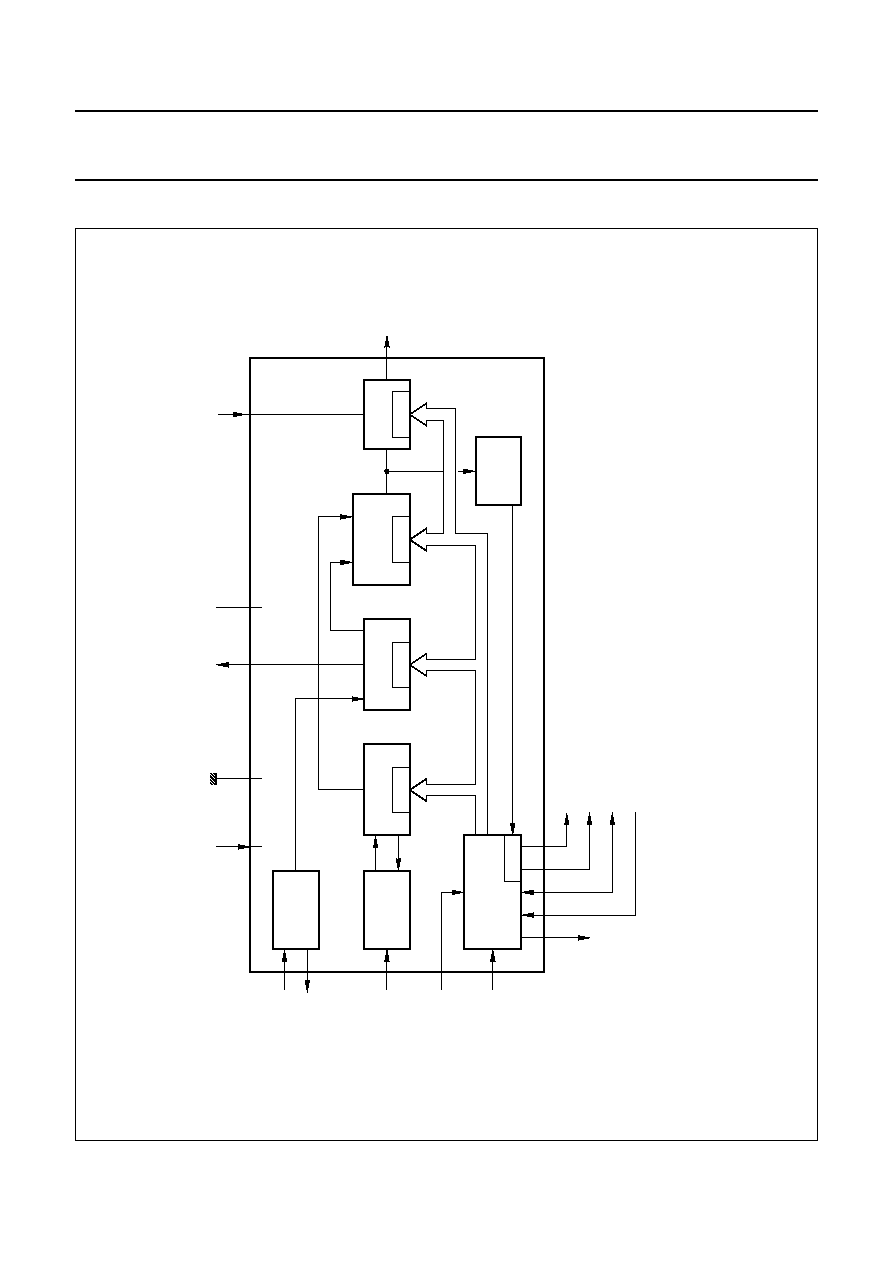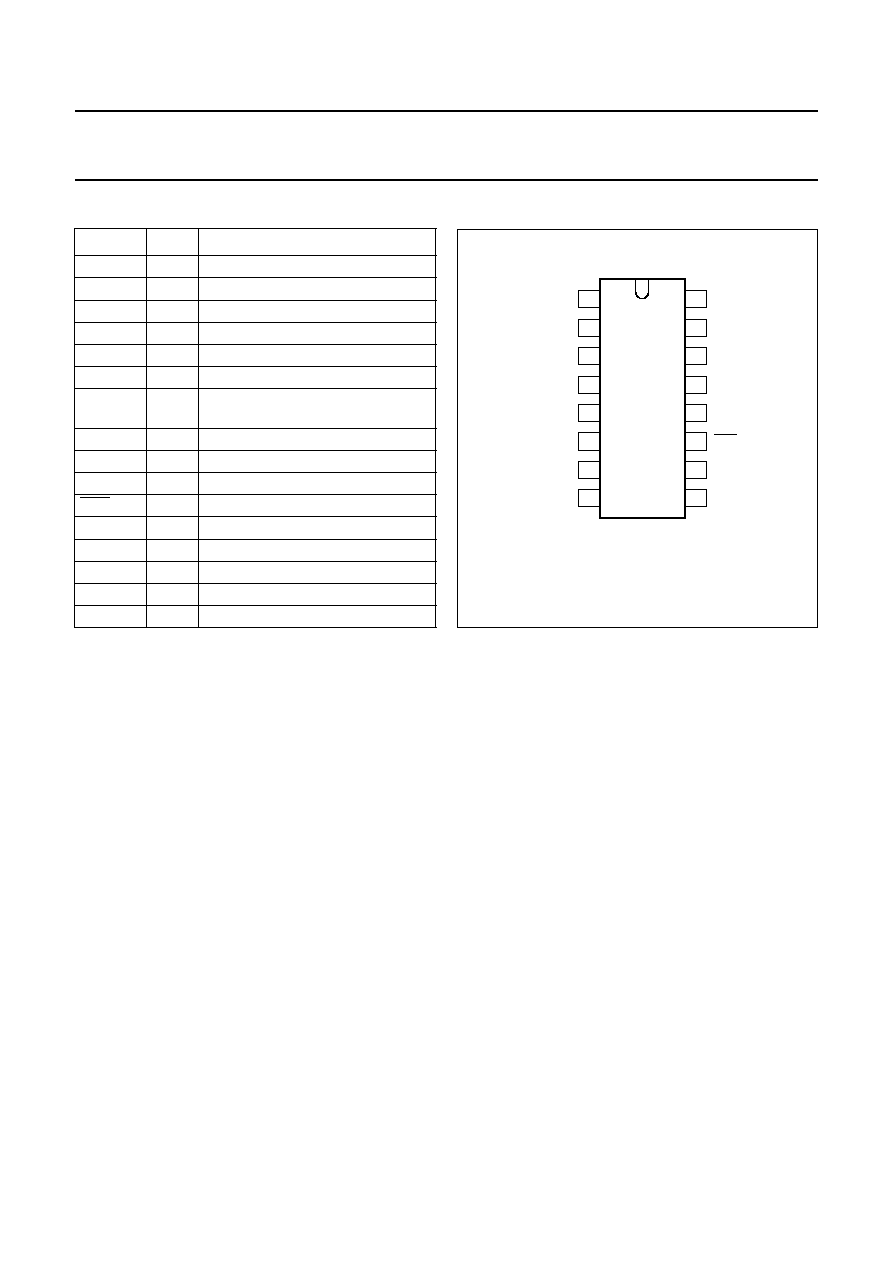
October 1992
2
Philips Semiconductors
Product specification
Low-power frequency synthesizer for
mobile radio communications
UMA1014
FEATURES
∑
Single chip synthesizer; compatible with Philips cellular
radio chipset
∑
Fully programmable RF divider
∑
I
2
C interface for two-line serial bus
∑
On-chip crystal oscillator/TCXO buffer from 3 to 16 MHz
∑
16 reference division ratios allowing 5 to 100 kHz
channel spacing
∑
1/8 crystal frequency output
∑
On-chip out-of-lock indication
∑
Two extra VCO control outputs
∑
Latched synthesizer alarm output
∑
Status register including out-of-lock indication and
power failure
∑
Power-down mode.
APPLICATIONS
∑
Cellular mobile radio (NMT, AMPS, TACS)
∑
Private mobile radio (PMR)
∑
Cordless telephones.
GENERAL DESCRIPTION
The UMA1014 is a low-power universal synthesizer which
has been designed for use in channelized radio
communication. The IC is manufactured in bipolar
technology and is designed to operate at 5 to 100 kHz
channel spacing with an RF input from 50 to 1100 MHz.
The channel is programmed via a standard I
2
C-bus. A
low-power sensitive RF divider is incorporated together
with a dead-zone eliminated, 3-state phase comparator.
The low-noise charge pump delivers 1 mA or 1/2 mA
output current to enable a better compromise between fast
switching and loop bandwidth. A power-down circuit
enables the synthesizer to be set to idle mode.
QUICK REFERENCE DATA
ORDERING INFORMATION
SYMBOL
PARAMETER
MIN.
TYP.
MAX.
UNIT
V
CC
, V
CP
supply voltage range
4.5
5.0
5.5
V
I
CC
+ I
CP
supply current
-
13
-
mA
I
CCpd
I
CC
in power-down
-
2.5
-
mA
f
ref
phase comparator reference frequency
5
-
100
kHz
f
RF
RF input frequency
50
-
1100
MHz
T
amb
operating ambient temperature range
-
40
-
85
∞
C
TYPE NUMBER
PACKAGE
NAME
DESCRIPTION
VERSION
UMA1014T
SO16
plastic small outline package; 16 leads; body width 3.9 mm
SOT109-1

October 1992
5
Philips Semiconductors
Product specification
Low-power frequency synthesizer for
mobile radio communications
UMA1014
FUNCTIONAL DESCRIPTION
The UMA1014 is a low-power frequency synthesizer for
radio communication which operates in the
50 to 1100 MHz range. The device includes an
oscillator/buffer circuit, a reference divider, an RF divider,
a 3-state phase comparator, a charge pump and a main
control circuit to transfer the serial data into the four
internal 8-bit registers. The V
CC
supply feeds the logic part,
the V
CP
supply feeds the charge-pump only. Both supplies
are +5 V (
±
10%). The power-down facility puts the
synthesizer in the idle mode (all current supplies are
switched off except in the control part). This allows any I
2
C
transfer and all information in the registers is retained thus
enabling fast power-up.
Main divider
The main divider is a pulse swallow type counter which is
fully programmable. After a sensitive input amplifier
(50 mV,
-
13 dBm), the RF signal is applied to a 31/32
duo-modulus counter. The output is then used as the clock
for the 5-bit swallow counter R = (MD4 to MD0) and the
13-bit main counter N = (MD17 to MD5). The ratio is
transferred via the I
2
C-bus to the registers B, C and D, and
then buffered in an 18-bit latch. The ratio in the divider
chain is updated with the new information when the least
significant bit is received (i.e. D0). This update is
synchronized to the output of the divider in order to limit the
phase error during small jumps of the synthesized
frequency.
The main divider can be programmed to any value
between 2048 and 262143 (i.e. 2
18
-
1). If ratio X, below
2048, is sent to the divider, the ratio (X + 2048) will be
programmed. When it is required to switch between
adjacent channels it is possible to program register D only,
thus allowing shorter I
2
C programming time.
Oscillator
The oscillator is a common collector Colpitts type with
external capacitive feedback. The oscillator has very small
temperature drift and high voltage supply rejection. A
TCXO or other type of clock can be used to drive the
oscillator by connecting the source (preferably
AC-coupled) to pin 1 and leaving pin 2 open-circuit. The
oscillator acts as a buffer in this mode and requires no
additional external components. The signal from the clock
source should have a minimum space width of 31 ns.
Reference divider
The reference divider is semi-programmable with 16
division ratios which can be selected via the I
2
C-bus. The
programming uses four bits of the register A (A3 to A0) as
listed in Table 2. These ratios allow the use of a large
number of crystal frequencies from 3 MHz up to 16 MHz.
All main channel spacings can be obtained with a single
crystal/TXCO frequency of 9.6 MHz.
Phase comparator
A diagram of the phase comparator and charge pump is
illustrated in Fig.3.
The phase comparator is both a phase and frequency
detector. The detector comprises dual flip-flops together
with logic circuitry to eliminate the dead-zone. When a
phase error is detected the UP or DOWN signal goes
HIGH. This switches on the corresponding current
generator which produces a source or sink current for the
loop filter. When no phase error is detected PCD goes high
impedance. The final tuning voltage for the VCO is
provided by the loop filter. The charge pump current is
programmable via the I
2
C-bus. When IPCD (bit 5) is set to
logic 1 the charge pump delivers 1 mA; when IPCD is set
to logic 0 the charge pump delivers 0.5 mA.
The phase comparator has a phase inverter logic input
(PHI). This allows the use of inverted or non-inverted loop
filter configurations. It is thus possible to use a passive
loop filter which offers higher performances without an
operational amplifier. The function of the phase
comparator is given in Table 3 and a typical transfer curve
is illustrated in Fig.4.
Out-of-lock detector
An out-of-lock detector using the UP and DOWN signals
from the phase comparator is included on-chip. The pin
VCOA is an open collector output which is forced LOW
during an out-of-lock condition. The same information is
also available via the I
2
C-bus in the status register (bit
OOL). When the phase error (measured at the phase
comparator) is greater than approximately 200 ns, an
out-of-lock condition is immediately flagged. The flag is
only released after 6 reference cycles when the phase
error is less than 200 ns.




